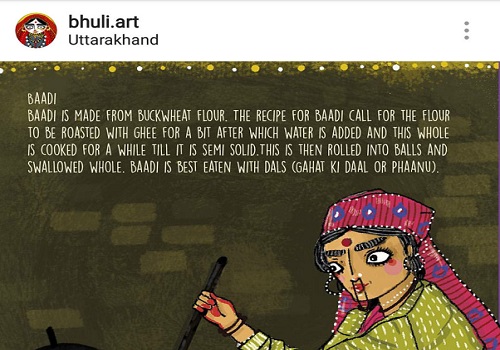Illustrated nutrition and reviving forgotten foods from Uttarakhand.
What do you get when a textile designer/ illustrator and a nutritionist join hands? An Instagram feed enlightening us on the culture, traditions and the food from their region- Uttarakhand. Tanya Kotnala and Tanya Singh created a little corner for their state in this online world of ours, illustrating the arts, textile, produce, recipes and some lesser-known facets of Uttarakhand. Their Instagram page Bhuli, which means “little girl” in Garhwali & Kumaoni, has more than 13 thousand followers. I spoke to Tanya Singh about all things food on Bhuli.
https://www.instagram.com/p/BYe6TgKAeSY/?taken-by=bhuli.art
Design meets Nutrition
Tanya Kotnala holds a degree in Fashion Designing from NIFT and has worked on different projects in Sikkim and Assam. She started Bhuli in March 2017 to initially revive the arts and crafts from the Uttarakhand region. Tanya Singh has a Masters degree in Nutrition from IHM Pusa and a Masters in Food Communication from The University of Gastronomic Sciences, Italy. She went on to work for an NGO in Bihar on a UNICEF project addressing maternal and child health. After moving back to Dehradun, Singh joined her family friend in her Bhuli journey to catalogue the food traditions as well.
“We found that the food part is also not much talked about in Uttarakhand, and that is why we decided to incorporate that aspect. We started providing information on maternal and child health, on breastfeeding etc. But we discovered, that people have forgotten the local foods and have lost touch with their food traditions.They have no idea about seasonality and about what grows, when. Through Bhuli, we thought we could start a dialogue about all this.”
https://www.instagram.com/p/Bg3gTEqgW9e/?taken-by=bhuli.art
Forgotten kitchen memories and produce that rarely make an appearance on people’s plates. How do you convey all that effectively? Pictures? No, illustrations! “Talking to people face to face is one thing, but on social media, you have to make it interesting enough for them to follow the conversation, and relate to it. We are not just talking about food here. There are stories behind the food. There are memories stored in these images. This is why we use illustrations- to paint memories and the food together. For eg., we wrote about the nutritional benefits of the Fiddlehead fern or Lingad. We see women collecting these ferns around Uttarakhand. But there is a proper method to forage them, and of course, the recipes that use them have a narrative of their own. Similarly, there is a festival called Phool Dei, where children collect flowers from the forest and shower each house with flowers and rice. This is an example of celebrations that come with the food. There is so much to talk about.“
Team #bhuli on the wonders of illustrated nutrition. Click To TweetOn Nostalgia and Fame
While they were hoping to get people thinking about these foods and going local, little did they expect the response they received. Numerous emails from people across India, sharing memories, recipes and their own food stories. “We featured a small post on the sil-batta and how women made chutneys and masalas on it. There was someone who wrote to us saying it brought back so many memories of her grandmother, who would use the same for making chutneys. She felt so happy seeing the post. People also emailed in recipes asking us if we could publish them, ” Tanya shares.
https://www.instagram.com/p/BZVDIM5g4ow/?taken-by=bhuli.art
The team shared information about seven locally grown crops along with recipes for the National Nutrition Week between September 1-7. They gained international attention after this when Food 52 picked up on their work and wrote about it. Tanya shares that they also collaborate on Government projects, like raising awareness during National Breastfeeding Week, sharing information on anaemia and the importance of infant nutrition. “The Anganwadi workers are trained only once when they join the government. After that they are so absorbed in their regular work, and there is so much they have to do, that they don’t have time to learn what’s new. If they are not updated with new information, how will they pass it on to mothers and children? Our posters are designed to help them easily understand newer concepts and to help them stay updated.”
Illustrations that speak a 1000 words
In a time when food images are widely consumed, Bhuli’s illustrations seem to be a refreshing change of pace and effective in getting the message through. “We need to love and cherish what is real and true. We are trying to bring people back to what’s local, what’s traditional and what’s a huge part of their upbringing. Illustrations help us in evoking those memories. We are not trying to beautify food. For us, aesthetics is about in keeping it real.”
https://www.instagram.com/p/BeUVFn-Ast_/?taken-by=bhuli.art
The Bhuli team is currently sharing illustrations from their Nutrition Series-2. Tanya says that as they move forward, she hopes to create a repository of cooking methods and recipes. The team also wants to work on fusion methods to make some of these recipes suitable for the newer and more versatile palates. Chefs and culinary enthusiasts have reached out to them proposing different projects that will revolve around the local produce. The team wants to encourage local farmers and create a strong market for everything they grow. Even with all the fame and following, Bhuli seems steadfast in her goals. “Our food culture is in danger, and we really need to preserve it.” An important message for all of us.
For more information visit Bhuli.
Side note: Food is just one aspect of the many wonderful things you will find on Bhuli. To keep this post in line with the goals of The Yellow Turmeric, my questions revolved around food. I would strongly recommend stopping by their feed to witness their work first hand and appreciate the efforts put into this endeavour.
You may also like
